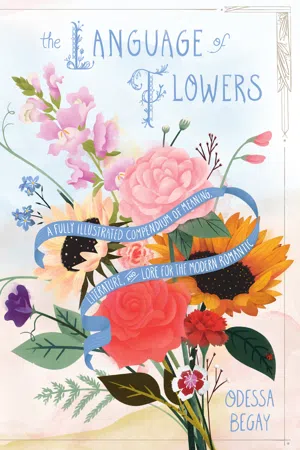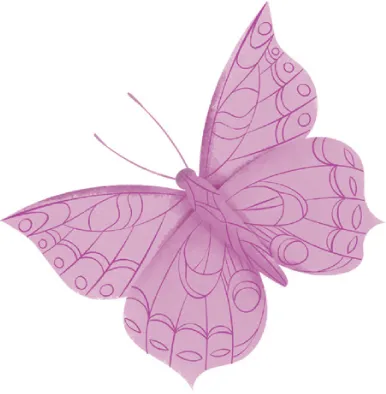Acacia
Robinia pseudoacacia
PURPLE: Significance uncertain
ROSE: Friendship
WHITE: Elegance
YELLOW: Concealed or secret love
The acacia’s extraordinary blossoms are papilionaceous, that is, resembling butterfly wings in form, a delightful characteristic. The term was beloved by the Victorians. In Floral Emblems, horticulturist Henry Phillips writes, “graceful to sight, and elegant hang the papilionaceous blossoms of this favorite flowering shrub.” In Flora’s Dictionary, Elizabeth Washington Wirt fondly notes the rose acacia’s “copious, large, pink-petaled, papilionaceous blossoms.”
The word acacia comes from the Greek root akakía, which roughly translates as “thorny Egyptian tree.” The acacia, as it’s described in the Victorian language of flowers, refers to the black locust tree, which has no relation to the Australian acacia tree (also known as the wattle), although both species are known to bear long sharp spines on their branches. Of the many species of the black locust bearing spiky branches, the yellow-flowered spiny acacia (Robinia spinosa) native to Russia and China was often used to line the tops of outer city and village walls as a defense to keep out intruders. In A General System of Gardening and Botany, the nineteenth-century Scottish botanist and explorer George Don writes that in Beijing, “they [stuck] the bushes in clay on the tops of their walls, to prevent persons from getting or looking over them” and that the shrub was “well adapted to grow as impenetrable hedges, on account of its long branches and long thorns.” The wood of the tree is sturdy and rot resistant. It has not only been put to great use as timber, but was also frequently used by Native Americans for making bows for hunting.
In Europe, especially in rural areas of France and Italy, acacia petals are often used in pancakes and fritters in spring, for this is when the flowers are beginning to bloom and are at their most tender and fragrant. The scent of the acacia is sweet, similar to that of honey, while its flavor varies from delicate and floral to slightly peppery. There are many recipes for these desserts to be found online, including locust-flower fritters from Jacques Pépin’s book Heart & Soul in the Kitchen.
Acacia petals are also used to flavor simple syrups and liquors as well as to make tea. The syrup or liquor can be made by steeping the flowers in boiling water, before adding sugar, while the tea can be made with fresh or dried flowers that are then boiled or steeped in hot water. The flowers may be edible, but the remaining parts of the tree are toxic and should be avoided. Some homeopathic herbal remedies say that when boiled, the seed pods and bark can be ingested in small quantities to help with digestive issues and convulsions, but this is not advised.
Light-leaved acacias, by the door,
Stood up in balmy air,
Clusters of blossomed moonlight bore,
And breathed a perfume rare.
—GEORGE MACDONALD
“Songs of the Spring Nights,” from The Disciple, and Other Poems, 1867
A FEAST OF FLOWERS
In Plant Lore, Legends, and Lyrics, Richard Folkard writes that garlands and chaplets (flower crowns) were commonly used by the ancient Egyptians to decorate themselves, their homes, and their altars. These often included anemones and chrysanthemums, and blooms from trees including acacia, olive, myrtle, and others. Folkard shares an anecdote written by Roman author, naturalist, and philosopher Pliny the Elder (AD 23–79), who says that at feasts, guests and attendants were adorned with wreaths, and homes and wine cups were adorned with flowers. It was a frequent custom for both Greeks and Romans to mix the flowers of their chaplets in their wine, then drink to the health of their friends.
One story recounts a feast held by Cleopatra and attended by Mark Antony, who, due to his fear of being poisoned, would never eat or drink at her table without his tester sampling first. Cleopatra ordered a chaplet of flowers, the edges of which were dipped in a deadly poison, to be prepared for the Roman general. Her own chaplet was mixed with aromatic spices. When the party had become lively from drink, Cleopatra raised a toast to Antony’s health, took off her chaplet, rubbed the blossoms into her goblet, and drank off the contents. Antony was about to follow her example but, just as he raised the fatal cup to his lips, Cleopatra seized his arm, exclaiming, “Cure your jealous fears and learn that I should not have to seek the means of your destruction, could I live without you.” Then, she ordered a prisoner to be brought before them, who, on drinking the wine from Antony’s goblet, died instantly in their presence.
Azalea
Rhododendron
Temperance
In 1603, after the shogunate arrived in Edo (feudal Tokyo) with their warrior caste of samurai, trade and travel between Japan and other countries ceased. This isolation had the effect of focusing societal concentration on a specific variety of practices and solidifying their place within the Japanese cultural identity. This was especially true for floriculture, the cultivation of flowering plants primarily for their ornamental qualities. Both upper and lower classes were able to enjoy the practice. Large gardens were a symbol of prestige, so samurai, who were high-ranking members of society, began to hire farmers to create and tend to elaborate flower gardens on their properties.
During the 1600s, Ito-Ihei III of the Somei area gained prominence as a skilled gardener and nurseryman and developed his knowledge of azaleas, many of which which are native to Japan. Sometime between 1682 and 1684, he began distributing them in the surrounding area. In 1692, he wrote Kinshumakura, an illustrated guide to azaleas that included more than three hundred cultivars he had developed, and enhanced their popularity in Japan.
In the mid-1840s, Scottish botanist Robert Fortune first brought the azalea, in the form of seeds, to England. Fortune had been sent to China by the British East India Company to spy on the Chinese and steal their secrets to tea production and horticultural practices. He managed to smuggle home a variety of seeds and plant cuttings. Some of these other plants included the yellow rose, kumquat, winter jasmine, and wisteria.
Azalea belongs to the Rhododendron genus of the Ericaceae family, which includes edible plants such as blueberries, huckleberries, and cranberries. Azaleas, however, are highly toxic. In fact, they are so toxic that even the honey they produce has proved to be poisonous. In Chinese culture, azaleas are referred to as sixiang shu, which translates to “thinking-of-home bush,” and they were often featured in the poetry of the prominent Tang dynasty poet, Du Fu (712–770).
Ornamental plants that can be grown in many colors and are easy to hybridize, azaleas became a staple of the English Victorian garden. Not only were they commonly available for purchase in an endless variety of sizes and colors through florists’ catalogs, but they also appeared in some turn-of-the-century books on floral arrangement as the primary, and sometimes only, flower in Christmas and Easter flower baskets and table arrangements. In Henry Phillips’s Floral Emblems, he writes that azaleas prefer poor, dry soil and do not fare well in the often overly fertilized soil of English gardens; therefore, they are an appropriate symbol of “temperance” for their ability to take only what they need to survive.
There is no difference between knowledge and temperance; for he who knows what is good and embraces it, w...










